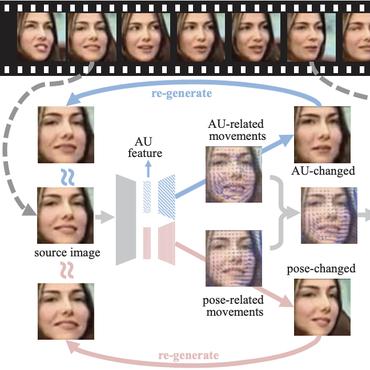Search Results for author: Rujie Liu
Found 13 papers, 3 papers with code
Generative Modelling with High-Order Langevin Dynamics
no code implementations • 19 Apr 2024 • Ziqiang Shi, Rujie Liu
In this paper, we propose a novel fast high-quality generative modelling method based on high-order Langevin dynamics (HOLD) with score matching.
HiCOMEX: Facial Action Unit Recognition Based on Hierarchy Intensity Distribution and COMEX Relation Learning
no code implementations • 23 Sep 2020 • Ziqiang Shi, Liu Liu, Zhongling Liu, Rujie Liu, Xiaoyu Mi, and Kentaro Murase
The features are input to a bidirectional long short-term memory (BiLSTM) layer for learning the intensity distribution.
Speech Separation Based on Multi-Stage Elaborated Dual-Path Deep BiLSTM with Auxiliary Identity Loss
1 code implementation • 6 Aug 2020 • Ziqiang Shi, Rujie Liu, Jiqing Han
We have open sourced our re-implementation of the DPRNN-TasNet here (https://github. com/ShiZiqiang/dual-path-RNNs-DPRNNs-based-speech-separation), and our TasTas is realized based on this implementation of DPRNN-TasNet, it is believed that the results in this paper can be reproduced with ease.
La Furca: Iterative Context-Aware End-to-End Monaural Speech Separation Based on Dual-Path Deep Parallel Inter-Intra Bi-LSTM with Attention
1 code implementation • 23 Jan 2020 • Ziqiang Shi, Rujie Liu, Jiqing Han
We have open-sourced our re-implementation of the DPRNN-TasNet in https://github. com/ShiZiqiang/dual-path-RNNs-DPRNNs-based-speech-separation, and our `La Furca' is realized based on this implementation of DPRNN-TasNet, it is believed that the results in this paper can be smoothly reproduced.
Sound Audio and Speech Processing
Learning to Find Correlated Features by Maximizing Information Flow in Convolutional Neural Networks
no code implementations • 30 Jun 2019 • Wei Shen, Fei Li, Rujie Liu
We argue that the discard of the correlated discriminative information is partially caused by the fact that the minimization of the classification loss doesn't ensure to learn the overall discriminative information but only the most discriminative information.
FurcaNeXt: End-to-end monaural speech separation with dynamic gated dilated temporal convolutional networks
no code implementations • 12 Feb 2019 • Ziqiang Shi, Huibin Lin, Liu Liu, Rujie Liu, Jiqing Han, Anyan Shi
Deep dilated temporal convolutional networks (TCN) have been proved to be very effective in sequence modeling.
Sound Audio and Speech Processing
Learning to generate filters for convolutional neural networks
no code implementations • ICLR 2018 • Wei Shen, Rujie Liu
In this paper, we propose to generate sample-specific filters for convolutional layers in the forward pass.
Tackling Early Sparse Gradients in Softmax Activation Using Leaky Squared Euclidean Distance
no code implementations • 27 Nov 2018 • Wei Shen, Rujie Liu
However, we find that choosing squared Euclidean distance may cause distance explosion leading gradients to be extremely sparse in the early stage of back propagation.
Generating Attention from Classifier Activations for Fine-grained Recognition
no code implementations • 27 Nov 2018 • Wei Shen, Rujie Liu
Recent advances in fine-grained recognition utilize attention maps to localize objects of interest.
Multi-view (Joint) Probability Linear Discrimination Analysis for Multi-view Feature Verification
no code implementations • 20 Apr 2017 • Ziqiang Shi, Liu Liu, Mengjiao Wang, Rujie Liu
However, in practical use, when using multi-task learned network as feature extractor, the extracted feature are always attached to several labels.
Learning Residual Images for Face Attribute Manipulation
1 code implementation • CVPR 2017 • Wei Shen, Rujie Liu
The transformation networks are responsible for the attribute manipulation and its dual operation and the discriminative network is used to distinguish the generated images from real images.
Empirical study of PROXTONE and PROXTONE$^+$ for Fast Learning of Large Scale Sparse Models
no code implementations • 18 Apr 2016 • Ziqiang Shi, Rujie Liu
Thus in some applications, in order to train sparse models fast, we propose to combine the merits of both methods, that is we use PROXTONE in the first several epochs to reach the neighborhood of an optimal solution, and then use the first order method to explore the possibility of sparsity in the following training.
Online and stochastic Douglas-Rachford splitting method for large scale machine learning
no code implementations • 22 Aug 2013 • Ziqiang Shi, Rujie Liu
Then we proved that the online DRs splitting method enjoy an $O(1)$ regret bound and stochastic DRs splitting has a convergence rate of $O(1/\sqrt{T})$.








